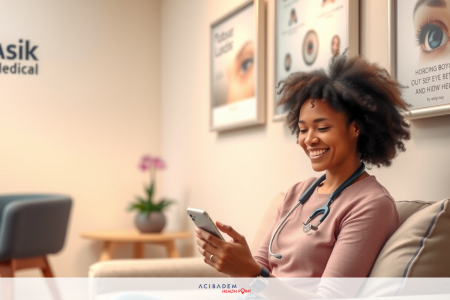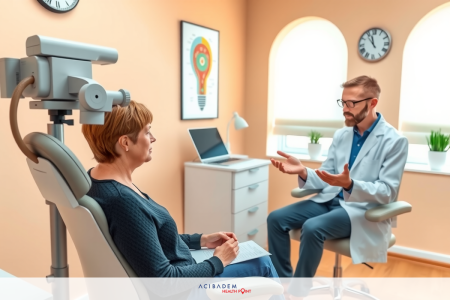Understanding Hypertropia Symptoms
Understanding Hypertropia Symptoms Hypertropia is a kind of strabismus where one eye looks up more than the other. This can cause problems with normal sight. It’s important to spot these symptoms early for quick and effective treatment.
This issue can affect daily tasks. Knowing its signs is key. We will look at different symptoms of hypertropia. It underlines why it’s crucial to be alert to this condition. Knowing these symptoms helps manage the disorder and keep life quality high.
What is Hypertropia?
Hypertropia is when one eye moves upward. It makes each eye not work well with the other. This can cause many vision problems. It’s important to understand this condition. That way, you can know how to treat it.
Definition of Hypertropia
Hypertropia is a type of eye misalignment. One eye goes up more than the other. This happens a lot, but not always. It’s harder for the person to use both eyes together because of this. This can make it difficult to focus on one point.
Understanding Hypertropia Symptoms How Hypertropia Affects Vision
Hypertropia messes up how your eyes work together. So things might look wrong. You could see double or find it hard to guess distances. These problems can make life tough. But, there are ways to make things better through treatment.
Common Hypertropia Symptoms
Hypertropia can show up in many ways that really change daily life. Knowing these signs helps find it early and treat it well.
Visual Symptoms
Double vision stands out as a top symptom. It makes seeing one clear image hard, leading to blurry sights. Doing tasks that need sharp vision may be tough. Also, having eye strain is usual after long times of looking close, like reading or using a computer.
Physical Symptoms
People with hypertropia might turn their head to see better, avoiding double vision. Their head might look tilted or their posture strange. Plus, eye strain causing headaches and eye discomfort affects how they feel every day.
Behavioral Changes
Hypertropia can cause big changes in behavior too. Some might close or squint one eye to see clearer and feel less pain. This can make being with others hard and affect how sure they feel. Always trying to deal with the symptoms can make folks tired and less able to do things.
Signs of Hypertropia to Watch For
Hypertropia can show up in different ways. Sometimes, the signs come and go. Other times, they stay and are easy to see.
Intermittent vs. Constant Symptoms
People with off-and-on hypertropia might not always see the signs. It mainly happens when they’re tired or stressed. They might feel like they’re seeing double or have trouble focusing. However, if it’s constant, they’ll always have trouble seeing clearly. This could be due to the eyes not lining up right.
Understanding Hypertropia Symptoms Mild vs. Severe Cases
Understanding Hypertropia Symptoms How bad hypertropia is changes what someone might notice. In lighter cases, they might only see issues when reading or watching TV. But, if it’s more serious, they’ll have big trouble seeing. This can mess up their daily life a lot.
| Type of Symptom | Characteristics |
|---|---|
| Intermittent Misalignment | Occurs only at times, often during stress or fatigue. |
| Constant Hypertropia | Persistent, noticeable misalignment with continuous vision problems. |
| Mild Cases | Minimal symptoms, often during specific activities. |
| Severe Eye Conditions | Pronounced misalignment causing significant visual impairment. |
Causes of Hypertropia
It’s key to know why hypertropia happens for the right treatment. We’ve found several major causes.
Genetic Factors
Inherited eye conditions often link back to it. If your family has eye misalignments, you might, too. Studies show that changes in how nerves and muscles work can lead to hypertropia.
Neurological Causes
Neurological disorders are big factors, too. Things like cerebral palsy or brain injuries can mess up brain-eye muscle signals. This leads to eye misalignment.
Other Health Conditions
Certain health issues might also lead to hypertropia. Illnesses like thyroid problems or diabetes can be a cause. It’s crucial to treat these to fix the eye misalignment.
| Cause | Contribution to Hypertropia |
|---|---|
| Genetic Factors | Inherited predisposition from family history of eye conditions |
| Neurological Disorders | Disruption of nerve signals due to brain injuries or diseases |
| Associated Health Issues | Impact of systemic diseases like diabetes and thyroid disorders on eye muscles |
Understanding Hypertropia Symptoms How Hypertropia is Diagnosed
To diagnose hypertropia, doctors use special tests. These tests look at the health and alignment of the eyes. A detailed eye exam is key to finding hypertropia. It shows how the eye muscles work and if they line up correctly.
At the start of the exam, an eye doctor checks the patient’s vision and eye movements. They also test how well the patient can focus. These tests are very important for figuring out hypertropia.
The doctor then uses special eye tests to learn more. These tests can include:
- Cover Test: Shows how one eye moves when the other is covered. This helps find eye misalignments.
- Prism and Alternate Cover Test: Uses prisms to see how much the eyes are misaligned.
- Stereopsis Test: Checks the patient’s depth perception, which hypertropia can affect.
The chart below shows the tests and what they’re for in the diagnosis:
| Procedure | Purpose |
|---|---|
| Comprehensive Eye Exam | Checks vision, eye health, and basic alignment. |
| Cover Test | Looks at eye movements and finds misalignment. |
| Prism and Alternate Cover Test | Uses prisms to measure how much eyes are misaligned. |
| Stereopsis Test | Tests depth perception, which hypertropia can impact. |
Hypertropia Treatment Options
Treatment for hypertropia includes non-surgical and surgical ways. Its aim is to better how your eyes work together and help your eye health. Let’s look at these treatments closely.
Non-Surgical Treatments
For many people, non-surgical steps work well to handle hypertropia. These steps can include:
- Vision Therapy: It’s a set of activities to boost how well your eye muscles work together. This therapy is made just for you.
- Corrective Glasses: With certain lenses, your sight gets better by changing how light hits your eyes. This reduces hypertropia.
Starting with these non-surgical methods is common. They aim to fix eye alignment and make you feel better.
Understanding Hypertropia Symptoms Surgical Treatments
When non-surgical ways don’t work, surgery might be the next step. Here are the surgical options:
- Strabismus Surgery: It realigns your eye muscles to correct where your eyes point. Strabismus surgery greatly helps with how your vision aligns.
- Advanced Techniques: Some surgeries offer ways to adjust things after the main surgery. This can make the surgery work even better.
Understanding Hypertropia Symptoms Doctors consider surgery if other treatments are not working or if hypertropia is very severe.
| Type of Treatment | Purpose | Outcome |
|---|---|---|
| Vision Therapy | Boost eye muscle teamwork | Eyes align better, less strain |
| Corrective Glasses | Change light direction | Lowers symptoms of hypertropia |
| Strabismus Surgery | Adjust the eye muscles | Big improvement in eye alignment |
Knowing about these treatments helps you work with your healthcare team to choose the best path. This can lead to better results and a happier life.
Hypertropia in Children
Hypertropia is a special form of strabismus. One eye looks higher than the other. This may greatly affect kids, changing how they see the world. Dealing with this issue early is key for good eye health in kids.
Early Diagnosis
Spotting hypertropia in kids early is really important. If left untreated, it can mess with how well they see and learn. Getting eyes checked often catches problems soon. Pediatricians can often spot signs early. They might then send the kid to an eye doctor for more tests.
Special Considerations for Children
Kids with hypertropia need special care. They are in a big stage of growing both their sight and their mind. If the problem isn’t fixed, it might lead to trouble learning. To help, they might need glasses, eye patches, or maybe even surgery. And, checking in regularly with the doctor is key. This way, they can tweak the treatment to fit the kid’s needs.
Understanding Hypertropia Surgery
When you pick corrective surgery for hypertropia, understanding the process is key. It ensures the surgery goes well.
Types of Surgical Procedures
Many surgeries fix hypertropia, depending on our eye’s misalignment. Some common ones are:
- Recession: It moves a muscle back to weaken its effect.
- Resection: It shortens a muscle, making it stronger.
- Adjustable suture surgery: This lets the doctor fine-tune the alignment after the operation.
What to Expect During Surgery
Surgery for hypertropia is typically done in a day. It’s under general anesthesia. Here’s what happens:
- They get you ready and apply anesthesia.
- The team works to fix the eye’s alignment by adjusting muscles.
- You stay in the recovery room before going home on the same day.
Recovery Process Post-Surgery
After surgery, taking good care is very important. This often includes:
- Using eye drops to stop infections and lower swelling.
- Visiting the doctor to check healing and alignment progress.
- Not doing too much physically for a smooth recovery.
Following your doctor’s advice during the recovery is crucial for good results.
Effective Hypertropia Management Techniques
Managing hypertropia means doing things every day to help your eyes. It’s about making your vision better and enjoying life more. This part shares helpful ideas and tips for taking care of your eyes.
Daily Management Tips
Follow specific routines and do exercises daily to help with hypertropia. Try these eye workouts and other advice to keep your eyes in good shape:
- Regular Eye Exercises: Doing eye exercises daily can make your eye muscles stronger. This can help your eyes work better together.
- Proper Lighting: Make sure the places you spend time in are well-lit. This helps your eyes not get tired and lessen hypertropia symptoms.
- Rest Breaks: It’s important to take breaks. Especially when you’re focused on something, like reading or using a computer. This helps manage your vision disorders.
- Hydration and Diet: Eat foods with vitamins and drink enough water. This keeps your eyes healthy.
Long-Term Management Strategies
Keeping your eyes healthy in the long run is also crucial. Here are some ideas for the future:
- Regular Check-Ups: See your eye doctor often for check-ups. They can track your progress and tweak your treatment, if needed.
- Customized Treatment Plans: Your healthcare team can create a plan just for you. It might include special glasses or prisms.
- Staying Informed: Learn about new treatments for hypertropia. Knowing what’s new can help you find better ways to manage it.
- Support Networks: Join groups where you can talk to others with vision issues. You can share tips and learn from their experiences.
By doing daily exercises and planning for the long term, you can better handle hypertropia. This way, you can live a happy life with good vision.
Hypertropia Exercises for Improvement
Improving your hypertropia can be done with eye exercises. These exercises work on the eye muscles. They make better alignment and can improve your vision. Adding them to your daily routine can make hypertropia symptoms better over time.
One good exercise is to look at a small object and move it closer. Do this without losing focus. This makes your eyes and their muscles work together better. Also, cover one eye at a time and read. This helps with muscle control and alignment.
Doing these exercises every day can slowly make hypertropia better. You need to be patient and do them regularly. Talk to your eye doctor about these exercises. They can help you fit them into your daily life for healthier eyes.
FAQ
What are the common symptoms of hypertropia?
Common symptoms are double vision, eye strain, and odd head positions. People might have a hard time coordinating their vision. This leads to one eye looking upward more than the other.
How does hypertropia affect vision?
It causes the eyes to be out of line vertically. This makes seeing with both eyes hard. It can affect seeing depth and focusing, creating visual problems. These issues affect daily life and tasks that need good vision.
What are the physical symptoms associated with hypertropia?
Physical signs include eye misalignment and an eye drifting upward. People may also tilt their head to help see straight. They might close one eye to avoid seeing double.
How can you differentiate between intermittent and constant hypertropia?
Intermittent hypertropia shows up sometimes, not all the time. Constant hypertropia is always there. Symptoms from constant cases can be more severe and affect vision more often.
What are the main causes of hypertropia?
It can come from genes, or from issues with the brain or health conditions. It might show up at birth, after an injury, or due to other health problems. These can affect how the eyes and nerves work together.
How is hypertropia diagnosed?
A full eye checkup is needed to diagnose hypertropia. This includes checking how the eyes align and move. Doctors might use special tests to find out if hypertropia is present and how bad it is.
What treatments are available for hypertropia?
Treatments range from glasses and therapy to eye surgery. The right treatment depends on how severe it is and what's causing it. Surgery to correct the eye's position is often used for serious cases.
Why is early diagnosis of hypertropia in children important?
Early diagnosis in children is important for their growth and learning. Treating it early gives better results and can avoid eye problems later. It's important for children's eye health and development.
What types of surgical procedures are performed for hypertropia?
Surgeries aim to fix the eye muscles and align the eyes. The specific way they do this depends on the person. It may involve changing the length or position of some eye muscles.
What are effective hypertropia management techniques?
Good management includes eye exercises, wearing the right glasses, and regular eye doctor visits. These practices help control symptoms and keep the eyes healthy. This improves life for those with hypertropia.
Are there exercises that can help improve hypertropia?
Yes, exercising the eye muscles can make the eyes work better together. This can improve eye health and lessen hypertropia symptoms. An eye specialist can suggest the best exercises for each person.













